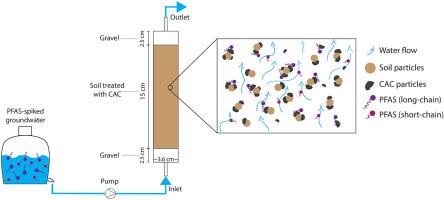Environmental Pollution ( IF 8.9 ) Pub Date : 2022-06-21 , DOI: 10.1016/j.envpol.2022.119667 Georgios Niarchos 1 , Lutz Ahrens 2 , Dan Berggren Kleja 3 , Fritjof Fagerlund 1

|
Developing effective remediation methods for per- and polyfluoroalkyl substance (PFAS)-contaminated soils is a substantial step towards counteracting their widespread occurrence and protecting our ecosystems and drinking water sources. Stabilisation of PFAS in the subsurface using colloidal activated carbon (CAC) is an innovative, yet promising technique, requiring better understanding. In this study, dynamic soil column tests were used to assess the retardation of 10 classical perfluoroalkyl acids (PFAAs) (C5–C11 perfluoroalkyl carboxylic acids (PFCAs) and C4, C6, C8 perfluoroalkane sulfonates (PFSAs)) as well as two alternative PFAS (6:2 and 8:2 fluorotelomer sulfonates) using CAC at 0.03% w/w, to investigate the fate and transport of PFAS under CAC treatment applications. Results showed high retardation rates for long-chain PFAS and eight times higher retardation for the CAC-treated soil compared to the non-treated reference soil for the ∑PFAS. Replacement of shorter chain perfluorocarboxylic acids (PFCAs), such as perfluoropentanoic acid (PFPeA), by longer chained PFAS was observed, indicating competition effects. Partitioning coefficients (Kd values) were calculated for the CAC fraction at ∼103–105 L kg−1 for individual PFAS, while there was a significant positive correlation (p < 0.05) between perfluorocarbon chain length and Kd. Mass balance calculations showed 37% retention of ∑PFAS in treated soil columns after completion of the experiments and 99.7% higher retention rates than the reference soil. Redistribution and elution of CAC were noticed and quantified through organic carbon analysis, which showed a 23% loss of carbon during the experiments. These findings are a step towards better understanding the extent of CAC's potential for remediation of PFAS-contaminated soil and groundwater and the limitations of its applications.
中文翻译:

使用动态柱实验通过胶体活性炭 (CAC) 保留全氟和多氟烷基物质 (PFAS)
为全氟烷基物质和多氟烷基物质 (PFAS) 污染的土壤开发有效的修复方法是朝着遏制其广泛发生和保护我们的生态系统和饮用水源迈出的重要一步。使用胶体活性炭 (CAC) 稳定地下 PFAS 是一项创新但有前途的技术,需要更好的理解。在这项研究中,动态土壤柱测试用于评估 10 种经典全氟烷基酸 (PFAA)(C 5 -C 11全氟烷基羧酸 (PFCA) 和 C 4、C 6、C 8全氟烷烃磺酸盐 (PFSA)) 以及两种替代的 PFAS(6:2 和 8:2 氟调聚物磺酸盐),使用 0.03% w/w 的 CAC,研究在 CAC 处理应用下 PFAS 的命运和运输。结果表明,与 ∑PFAS 的未处理参考土壤相比,长链 PFAS 的延迟率高,CAC 处理的土壤的延迟率高 8 倍。观察到用较长链的 PFAS 替代较短链的全氟羧酸 (PFCA),例如全氟戊酸 (PFPeA),表明存在竞争效应。计算 CAC 分数的分配系数(K d值)~10 3 –10 5 L kg -1对于单个 PFAS,而全氟化碳链长与K d之间存在显着的正相关(p < 0.05)。质量平衡计算表明,在实验完成后,处理过的土壤柱中 ∑PFAS 的保留率为 37%,保留率比参考土壤高 99.7%。通过有机碳分析发现并量化了 CAC 的重新分布和洗脱,结果表明在实验过程中碳损失了 23%。这些发现是朝着更好地了解 CAC 修复受 PFAS 污染的土壤和地下水的潜力及其应用局限性迈出的一步。


























 京公网安备 11010802027423号
京公网安备 11010802027423号